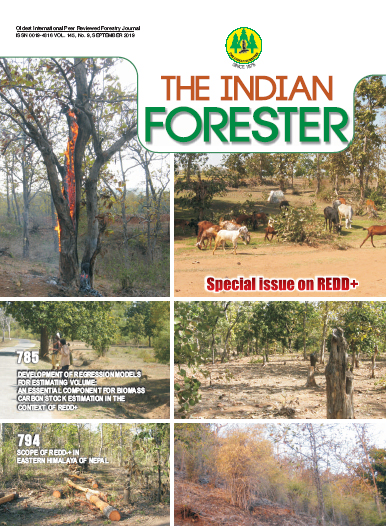Implementation of REDD+ Activities in North-Eastern States of India: A Case Study from The State of Mizoram
DOI:
https://doi.org/10.36808/if/2019/v145i9/148720Keywords:
REDD , Mizoram, Drivers, Deforestation, Forest Degradation.Abstract
Role of forests is well recognised as low-cost carbon mitigation option along with significant co-benefits. REDD+ is one of the climate change mitigation option in developing countries relating to reducing emissions from deforestation and forest degradation, role of conservation, sustainable management of forests and enhancement of forest carbon stocks. Implementation of REDD+ Himalaya Project was focused in North- Eastern states of India whereas Mamit District of Mizoram was chosen as REDD+ pilot project site for implementation of various field activities under the project. Shifting cultivation, fuel wood collection and over exploitation of non-wood forest products were identified as major direct drivers whereas lack of sufficient employment opportunities and awareness were identified as major indirect drivers of deforestation and forest degradation. These identified drivers were also responsible for loss of biodiversity. Strategies were also identified to address the drivers of deforestation and forest degradation. Feasibility study showed that implementation of activities such as promotion of agroforestry, shaded coffee plantation, use of improved cook stoves and solar energy etc. can address the drivers of deforestation and forest degradation which will also provide carbon and non-carbon benefits to the local communities. A total forest carbon stock of 2916 million tonnes was estimated from the pilot project site. State REDD+ Action Plan has also been prepared to support implementation of National REDD+ Strategy and will also be helpful in obtaining result based payment and other social and environmental co-benefits for the state of Mizoram.References
Anon. (nd). Report of the Working Group of Sub-National Committee of the National Development Council on Agriculture and related issues on dryland/rainfed farming system including regeneration of dryland wasteland, watershed development programme. Planning Commission, New Delhi.
Batjes N.H. (1996). Total carbon and nitrogen in the soils of the world. European J. Soil Science, 47:151-163.
FSI (2015). India State of Forest Report, 2015. Forest Survey of India, Dehradun.
FSI (2017). India State of Forest Report, 2017. Forest Survey of India, Dehradun.
Government of Mizoram (nd). Economic Survey 2015-16. Planning & Programme Implementation Department Government of Mizoram, India.
ICFRE (2018). Mizoram State REDD+ Action Plan, Indian Council of Forestry Research and Education, Dehradun (India).
IPCC (2003). Good Practice Guidance for Land Use, Land-Use Change and Forestry. Penman, J., Gytarsky, M., Hiraishi, T., Krug, T., Kruger, D., Pipatti, R., Buendia, L., Miwa, K., Ngara, T., Tanabe, K. and Wagner, F., Eds., Institute for Global Environmental Strategies (IGES), Kanagawa.
IPCC (2014). Climate Change 2014: Mitigation of Climate Change. Contribution of Working Group III to the Fifth Assessment Report of the Intergovernmental Panel on Climate Change (Edenhofer, O., R. Pichs-Madruga, Y. Sokona, E. Farahani, S. Kadner, K. Seyboth, A. Adler, I. Baum, S. Brunner, P. Eickemeier, B. Kriemann, J. Savolainen, S. Schlomer, C. von Stechow, T. Zwickel and J.C. Minx, eds.). Cambridge University Press, Cambridge, United Kingdom and New York, NY, USA.
Rawat V.R.S., Rawat R.S. and Verma N. (2017). Drivers of Deforestation and Forest Degradation in Mizoram. Indian Council of Forestry Research and Education, Dehradun (India).
Rawat R.S., Rawat V.R.S., Verma N. and Rawat J. (2018a). Strategies for Addressing the Drivers of Deforestation and Forest Degradation in the State of Mizoram. Indian Council of Forestry Research and Education, Dehradun (India).
Rawat R.S., Rawat V.R.S., Verma N., Arora G. and Rawat J. (2018b). Identification and Adoption of Appropriate Technology for REDD+ Implementation in Mizoram. Indian Council of Forestry Research and Education, Dehradun (India).
Rawat R.S., Arora G. and Rawat V.R.S. (2018c). Strategies for High Conservation Networks and Biodiversity Indicators to be used for REDD+ implementation in Mizoram. Indian Council of Forestry Research and Education, Dehradun (India).
Rawat R.S., Arora G., Rawat J., Rawat V.R.S., Singson M.Z. and Ramchhanliana H. (2018d). Forest Carbon Stocks of REDD+ Project Area in Mizoram: Baseline Report. Indian Council of Forestry Research and Education, Dehradun (India).
Singh K.P. (1997). Mizoram. In: V. Mudgal and P.K. Hajra (eds.), Floristic diversity and conservation strategies in India. III. pp 1217-1256, BSI, Dehra Dun.
Walkley A.E. and Black J.A. (1934). An examination of the Degitjareff method for determining soil organic matter and proposed modification of the chromic acid titration method. Soil Science, 37:29-38.
Downloads
Downloads
Published
How to Cite
Issue
Section
License
Unless otherwise stated, copyright or similar rights in all materials presented on the site, including graphical images, are owned by Indian Forester.





